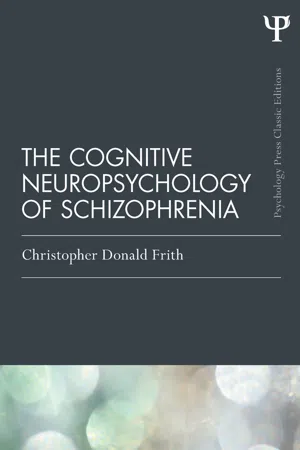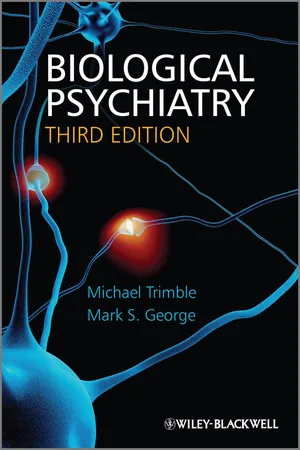Brain Abnormalities in Schizophrenia
Brain abnormalities in schizophrenia refer to structural and functional differences in the brains of individuals with this mental disorder. These abnormalities can include reduced gray matter volume, enlarged ventricles, and altered connectivity between brain regions. These differences are thought to contribute to the cognitive and perceptual disturbances characteristic of schizophrenia. Understanding these abnormalities is crucial for developing effective treatments for the disorder.
7 Key excerpts on "Brain Abnormalities in Schizophrenia"
- Amy E. Wenzel(Author)
- 2017(Publication Date)
- SAGE Publications, Inc(Publisher)
...Cumulatively, these findings suggest that lower glutamate levels may be integrally involved in the pathophysiology of schizophrenia. Structural and Functional Brain Abnormalities A number of structural and functional brain abnormalities have been found in schizophrenia patients compared with controls. For instance, alterations in brain volumes in patients with schizophrenia spectrum disorders, compared with controls, have been found in a number of structural magnetic resonance imaging (MRI) studies, including overall decreases in brain volumes (of approximately 3%), medial lobe structures (e.g., the amygdala, hippocampus, and parahippocampal gyrus), cortical regions (e.g., the prefrontal cortex), superior temporal gyri, the cerebellum, the corpus callosum, and the thalamus, as well as increases in ventricular structures (cavities in the brain that contain cerebral spinal fluid) and associated cerebrospinal fluid, which is created in and circulates through the ventricles, acting as a cushion for the brain. Furthermore, many of these structural abnormalities are associated with functional outcomes and symptoms of the disorder. For instance, reduced hippocampal volumes have been associated with learning and memory problems in schizophrenia spectrum disorders; reduced superior temporal gyri volumes have been associated with increases in symptoms, such as hallucinations; and reduced cortical volumes have been associated with problems in cognition in patients, such as attention and working memory difficulties. Although structural abnormalities appear to be present in a variety of brain regions, emerging evidence suggests that the connections between brain regions also appear to be disrupted in schizophrenia...
- Christopher Donald Frith(Author)
- 2015(Publication Date)
- Psychology Press(Publisher)
...This idea fits in well with the assumption of a genetic basis, but does not exclude other biological causes that affect early development. There is, as yet, no agreement as to the nature of this abnormality. A major problem for this proposal is to explain how it is that the cognitive consequences of this brain abnormality are manifested so late in life. Given that schizophrenia is associated with an abnormality of the brain, one of the primary concerns in the rest of this book is to consider how to relate the various signs and symptoms of schizophrenia to disturbances in particular brain systems....
- eBook - ePub
- Michael R. Trimble, Mark George(Authors)
- 2010(Publication Date)
- Wiley(Publisher)
...Recent data clearly suggest that abnormal hippocampal structure is associated with functional impairment of frontal-lobe activity, supporting a suggestion that the temporal/limbic changes may be primary. Alternatively, disturbances of frontal projections to the parietal and temporal association areas may impair sensory representations in these areas, explaining positive symptoms, setting the frontal lobes as crucial for the development of both positive and negative symptoms. More recent imaging studies have concerned changes in white-matter tracts and have identified alterations in white matter, including the corpus callosum, the uncinate fasciculus and the anterior limb of the internal capsule. It is quite unclear whether these are part of the structural alterations that relate to schizophrenia or are secondary to other neuronal loss. It does seem to be the case that many of the structural (and functional) changes occur early on in the disorder, are not secondary to antipsychotic drug prescriptions and may be seen in the high-risk group before diagnosis. The evidence for two distinct syndromes in schizophrenia has been pursued by Crow and colleagues (Crow, 1980). The suggestion is that there is both a neurochemical and a neuropathological contribution to schizophrenia, with two syndromes. Thus, the type I syndrome (equivalent to acute schizophrenia) is characterized by positive symptoms (delusions, hallucinations and thought disorder) and is related to change in dopaminergic transmission. The type II syndrome (equivalent to the defect state) is characterized by negative symptoms (affective flattening and poverty of speech) and is associated with intellectual impairment and structural changes in the brain. Current thought also involves a continuum model and includes consideration of the schizophrenia spectrum. It is established that abnormalities of cognition and thinking are present well before the onset of the actual psychosis...
- eBook - ePub
Clinical Neuroscience
Foundations of Psychological and Neurodegenerative Disorders
- Lisa Weyandt(Author)
- 2018(Publication Date)
- Routledge(Publisher)
...hippocampus, caudate nucleus, cerebellum, and putamen, as well as cytoarchitectural differences, including disorganized arrangements of neurons, misplacement of neurons, reduced receptors, fewer dendritic branches and dendritic spines, and reduction in neuronal size and number in cortical and subcortical regions; however, these findings are inconsistent across studies and are not unique to schizophrenia. Differences in glucose metabolism and BOLD signals in the striatum, frontal, temporal, and other brain regions have been reported in neuroimaging studies of patients with schizophrenia, although there is considerable variability of findings across studies. Although dopamine has been the primary focus of studies, additional neurotransmitter systems have been investigated in their role in schizophrenia, including GABA, acetylcholine, serotonin, and glutamate. Treatment of schizophrenia typically involves the use of antipsychotic medication although the mode of action of these drugs is not completely understood and not all individuals with schizophrenia respond favorably to antipsychotic medication. To date, no distinctive pattern of structural or functional abnormalities has been identified as reliably or uniquely characteristic of schizophrenia. Review Questions Does research support that individuals with schizophrenia have a higher propensity for violence? If you were to describe the “cause” of schizophrenia, how would you respond and why? What does twin research suggest about the etiology of schizophrenia? Summarize research concerning the role of dopamine genes in the development of schizophrenia. Describe methodological issues associated with the study of. schizophrenia. Enlarged ventricles are often associated with schizophrenia. Is this an appropriate association? Why or why not? Compare and contrast DAT and postsynaptic receptor findings with regard to schizophrenia. Compare and contrast typical versus atypical antipsychotic medications....
- eBook - ePub
- P. J. McKenna, P. J. McKenna(Authors)
- 2013(Publication Date)
- Routledge(Publisher)
...The findings are shown in Table 5.5. Mostly they are negative: only one study found progressive increase in lateral ventricular volume, with another finding an increase on the left in the setting of no overall change. Decreases, no change and, in one study, an increase relative to controls were found for overall brain or grey matter volume. There were only scattered findings of change in the frontal and temporal lobes and hippocampus and/or amygdala. Functional brain abnormality in schizophrenia As with brain structure, early studies of brain function in schizophrenia had to rely on a crude technique, in this case electroencephalography (EEG). Early EEG studies of schizophrenia claimed that slowing and other abnormalities could be seen in up to 80 per cent of patients. However, a critical review of this literature (Ellingson, 1954) plus two more recent surveys (Itil, 1977; Shagass, 1977) made it clear, first, that the rates of all abnormalities were considerably lower in studies that employed proper controls, and second, that the abnormalities seen consisted exclusively of nonspecific phenomena that also occurred with substantial frequency in normal individuals. Then, once again in the 1970s, the investigation of brain function in schizophrenia was transformed by the development of a much more powerful tool, functional imaging. This was first applied to schizophrenia in 1974 by Ingvar and Franzen. Using the relatively crude technique of 133 Xenon inhalation to measure regional cerebral blood flow, they compared 15 normal individuals (actually abstinent alcoholics), 11 patients with dementia and two groups of chronic schizophrenic patients, one consisting of 9 chronically hospitalised patients and the other of 11 younger chronic patients. Whereas the demented patients showed significantly reduced cerebral blood flow in all areas, in the schizophrenic patients global blood flow was not significantly different from the controls...
- eBook - ePub
- JOHN P CUTTING, Anthony David, JOHN P CUTTING, Anthony David(Authors)
- 2019(Publication Date)
- Psychology Press(Publisher)
...The patients were all medicated. As mentioned earlier, neuropsychology owes its distinctiveness from the rest of psychology by virtue of its reference to the brain. However, this has led to an obsession with brain localisation. While the location of schizophrenic disturbances to a cortical area would be a valuable achievement, the story would not end there. In fact this would provide but one link in a complete neuropsychology of schizophrenia chain, which would stretch from neural ultrastructure and chemical transmission to the most abstract of phenomenal experiences. Neuropsychology can justifiably regard as its legitimate domain the intervening steps between the abstract levels of representation—hallucinations, delusions, etc. and “pure” psychological phenomena, e.g. memory and attention. No direct reference may be made to the brain provided two underlying assumptions are held, namely, that these psychological processes may become distorted by dysfunction at a lower level—in the brain—and that schizophrenia is the manifestation of just such a distortion. In other words, cognitive psychology may be applied usefully to the study of schizophrenia but some reference to the biological underpinnings to cognition must be made eventually (Fleminger, Chapter 20 ; Bentall, Chapter 19 ; Slade, Chapter 15). This is the chief difference between the work done in the 1980s and earlier work. Much of the earlier endeavour may be described as “preneuropsychological” only insofar as neural bases for such phenomena as described by Green and Nuechterlein (Chapter 5) have yet to be elucidated fully. Green and Nuechterlein report abnormalities in processing visual information in schizophrenia, measured by a technique known as “backward masking”, in which two stimuli are presented for recognition, at different interstimulus intervals, with the purpose of evaluating the potency of the “sensory register” or “icon”; manics were equally impaired...
- eBook - ePub
Neuropathology of Drug Addictions and Substance Misuse Volume 2
Stimulants, Club and Dissociative Drugs, Hallucinogens, Steroids, Inhalants and International Aspects
- Victor R Preedy(Author)
- 2016(Publication Date)
- Academic Press(Publisher)
...Brain imaging studies have tried to find the structural abnormalities in patients with amphetamine psychosis. The prefrontal and temporal cortices are common brain regions which are often involved in the neuropathology of both amphetamine-induced and primary psychosis (Fusar-Poli, McGuire, & Borgwardt, 2012). The hippocampus and amygdala are also often involved in the pathophysiology of stimulant addiction, affective psychosis, and schizophrenia. Therefore, these medial temporal lobe structures may play an important role in the pathophysiology of amphetamine-induced psychosis (Shenton, Dickey, Frumin, & McCarley, 2001). Figure 2 Etiology of psychosis. Complex interaction of genetic and environmental factors. The figure provided a schematic view of multiple factors which contribute to develop a psychotic process. Data are from Tost, Alam, and Meyer-Lindenberg (2010), with permission from Elsevier. Table 4 presents magnetic resonance imaging findings of patients with amphetamine-induced psychosis. The volumetric measurement of brain in these patients revealed a significant reduction in gray matter volume compared with healthy controls. The reduction was significantly greater in the amygdala compared with the hippocampus. This pattern suggested was relatively specific to amphetamine-induced psychosis (Orikabe et al., 2011). One study also reported lower DAT density in the orbitofrontal cortex, dorsolateral prefrontal cortex, and amygdala of chronic amphetamine users, and suggested that this reduction may cause psychotic symptoms (Sekine et al., 2003). Also, imaging studies of chronic amphetamine users have consistently shown the reduction of DAT density in some parts of the dopaminergic systems, including the dorsal striatum, nucleus accumbens, and prefrontal cortex (Dalack et al., 1998). These structural changes can play an important role in developing amphetamine-induced psychosis...






